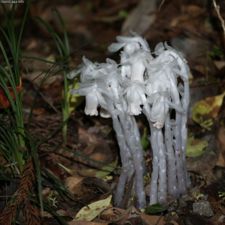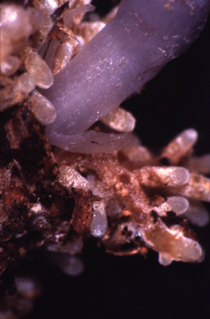Myco-heterotrophy
2007 Schools Wikipedia Selection. Related subjects: General Biology
Myco-heterotrophy is a symbiotic relationship between certain kinds of plants and fungi, in which the plant gets all or part of its food from parasitism upon fungi rather than from photosynthesis. A myco-heterotroph is the parasitic plant partner in this relationship. Myco-heterotrophy is considered a kind of cheating relationship and myco-heterotrophs are sometimes informally referred to as "mycorrhizal cheaters". This relationship is sometimes referred to as mycotrophy, though this term is also used for plants that engage in mutualistic mycorrhizal relationships.
Relationship between myco-heterotrophs and host fungi
Full (or obligate) myco-heterotrophy exists when a non-photosynthetic plant (a plant largely lacking in chlorophyll or otherwise lacking a functional photosystem) gets all of its food from the fungi that it parasitizes. Partial (or facultative) myco-heterotrophy exists when a plant is capable of photosynthesis, but parasitizes fungi as a supplementary food supply. There are also plants, such as some orchid species, that are non-photosynthetic and obligately myco-heterotrophic for part of their life cycle, and photosynthetic and facultatively myco-heterotrophic or non-myco-heterotrophic for the rest of their life cycle (Leake 1994). (It is important to note, however, that not all non-photosynthetic or " achlorophyllous" plants are myco-heterotrophic – some non-photosynthetic plants like dodder directly parasitize the vascular tissue of other plants (Dawson et al. 1994).)
In the past, non-photosynthetic plants were mistakenly thought to get food by breaking down organic matter in a manner similar to saprotrophic fungi. Such plants were therefore called " saprophytes". It is now known that no plant is physiologically capable of direct breakdown of organic matter and that in order to get food, non-photosynthetic plants must engage in parasitism, either through myco-heterotrophy or direct parasitism of other plants (Bidartondo et al. 2005, Leake 2005).
The interface between the plant and fungal partners in this association is between the roots of the plant and the mycelium of the fungus. It therefore closely resembles mycorrhiza (and indeed is thought to have evolved from mycorrhiza) (Bidartondo et al. 2005), except that in myco-heterotrophy, the flow of carbon is from the fungus to the plant, rather than vice versa (Trudell et al. 2003, Bidartondo et al. 2004).
Myco-heterotrophs can therefore be seen as ultimately being epiparasites, since they take energy from fungi that in turn get their energy from vascular plants (Bidartondo et al. 2005, Leake 2005). Indeed, much myco-heterotrophy takes place in the context of a common mycorrhizal network, in which plants use mycorrhizal fungi to exchange carbon and nutrients with other plants (Leake 2005). In these systems, myco-heterotrophs play the role of "mycorrhizal cheaters", taking carbon from the common network, but giving nothing in return (Bidartondo et al. 2005).
Species diversity of myco-heterotrophs and host fungi
Myco-heterotrophs are found among a number of plant groups. All monotropes and non-photosynthetic orchids are full myco-heterotrophs, as is the non-photosynthetic liverwort Cryptothallus. Partial myco-heterotrophy is common in the Gentian family, in photosynthetic orchids, and a number of other plant groups. Some ferns and clubmosses have myco-heterotrophic gametophyte stages (Leake 1994, 2005, Taylor et al. 2002). The fungi that are parasitized by myco-heterotrophs are typically fungi with large energy reserves to draw on, usually mycorrhizal fungi, though there is some evidence that they may also parasitize parasitic fungi that form extensive mycelial networks, such as Armillaria (Leake 2005).

